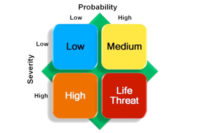In a recent poll we conducted of Environmental, Health and Safety (EHS) professionals, 39% of respondents indicated that data accuracy was the biggest data quality huddle that they faced. So, what is data accuracy? Data accuracy is one of the “six dimensions” of data quality and it can be defined as the “degree to which the data correctly describes the ‘real world’ objects being described.” This definition makes it easy to see how poor data accuracy could greatly impact your ability to use your data effectively. Since most EHS data, whether it be leading or lagging, is entered manually by employees in the field, data accuracy presents a particular challenge. In this article we will outline a major reason why data accuracy issues occur and how you can turn the tides.
The golden ticket fallacy
The golden ticket fallacy has been referenced in research and news articles as a causal factor for tuition increases at American universities. Students and parents overvalue the return on investment of college degrees. This overvaluation allows colleges to ramp up the price of tuition without much pushback because aspiring students believe that once you are in, everything else is gravy.
As EHS technologies have become more prevalent in the EHS landscape so has the golden ticket fallacy. Many companies implement the newest software and technology with the idea that once the new tech is up and running, there will be gold rush of data to influence the EHS programs. However, that is not typically how things pan out. More often, the new technology is implemented and as data comes rolling in there is missing information, incorrectly utilized fields/forms, and a general hodge-podge of information. Environmental, Health and Safety technologies should not be viewed as a golden ticket but more as a tool in the company’s toolbelt. When I buy the newest slickest power drill at the home improvement store a cannot expect the DIY projects to fix themselves (although if this tool exists, please send it my way). To get the most out of my investment I need to understand the tool’s purpose and set the parameters to achieve success.
How to achieve better data accuracy
Setup for success
Just because something can be done, does not mean that it should be done. One of the main reasons we see data accuracy problems in EHS data is because companies implement technologies beyond their current program. Setting up your EHS platform to meet your current capabilities is critical to allow for effective use of your system. This does not mean that we shouldn’t always be striving to improve and build a better more robust program. However, it does mean that when you are implementing a new technology the priority should be to implement something that matches your current capabilities. Getting ahead of your current program capabilities will lead to greater confusion, and hesitancy while using the new technology, which will in turn result in an increase in data accuracy issues. Let the technology meet you where you currently are, and then grow into the platform once you get adoption into the organization.
Train the data collectors
As I mentioned in the introduction. Environmental, Health and Safety data is especially subject to data accuracy errors because many of the data are manually entered. Training your data collectors cannot be overstated. If you want accurate data to leverage as a change agent, you need to have effective training for individuals who will be entering the data.
This training however should go beyond how to simply “push the buttons”. If you want robust and accuracy data, you need your team to understand the pivotal role they play in the effectiveness of your EHS program and platform. This means driving home the “why” of the technology and helping them understand the value proposition for accurate data. Training employees on how to push the buttons is a start, but helping employees see how their inputs will be turned into change agents sends a more powerful motivation for entering accurate data.
Lower the barrier
Employees, supervisors, and managers have a lot on their plate. If we want accurate data from the frontlines, we need to lower the barrier to entry. The more difficult and timelier it is to interact and enter information into the EHS platform, the less likely the information will be entered. As the old saying goes, convenience is king. The more convenient data entry is, the more accurate and robust the data.
Environmental, Health and Safety technologies play a pivotal role in revolutionizing health and safety in our workplaces. However, if you want to get the full value of your investment you need to be able to rely on your data to make data driven decisions. A key factor in your ability to use your data is ensuring you have data accuracy. Improved data accuracy means that the information that is entered into your EHS platform accurately depicts real world events. If you are looking to improve your data accuracy you should focus on setting up your system for success, training your data collectors and lowering the barrier to entry. With better EHS technologies and improved data accuracy we can take one step closer to eliminating death on the job by 2050.






